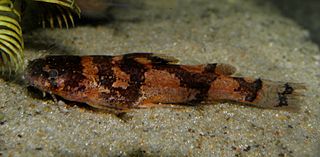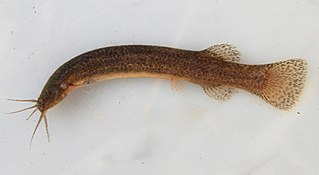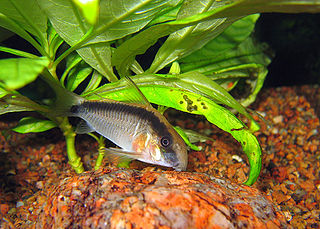
Hypostomus is a genus of catfish in the family Loricariidae. They are native to tropical and subtropical South America. H. plecostomus is the popular freshwater aquarium fish formerly known as Plecostomus plecostomus. The taxonomic structure of the Loricariidae is still being expanded by scientists. Hypostomus is a highly species-rich and widely distributed catfish genus.

Trichomycteridae is a family of catfishes commonly known as pencil catfishes or parasitic catfishes. This family includes the candiru fish, feared by some people for its alleged habit of entering into the urethra of humans. They are one of the few parasitic chordates. Another species is the life monsefuano which was important to the Moche culture and still an important part of Peruvian cuisine.
Listrura is a genus of pencil catfishes native to South America.

Trichomycterus is a genus of fish in the family Trichomycteridae, the largest genus of its family with over 170 species currently described. This genus is native to freshwater habitats in Central and South America. These fish are generally small, usually about 5 to 15 cm (2–6 in) in standard length, although the largest, T. rivulatus, can reach more than twice this size. Species differ from one another primarily in body proportions, fin ray counts and colouration. Despite their relatively small size, some, such as T. punctulatus, support fisheries and are important in the local cuisine.
Trichomycterus iheringi is a species of pencil catfish endemic to Brazil in São Paulo and Paraná states, centred on Santos where it is found in the Ribeira do Iguape River basin.

Microglanis is a genus of fish in the family Pseudopimelodidae native to South America. This genus has the widest distribution within its family, with species ranging from the Guianas to Venezuela; western slope of the Andes in Ecuador and Peru to the Río de La Plata basin in Argentina. They occur eastward to the Orinoco and Amazon basins. It is also present in the eastern coastal rivers of Brazil.

Parotocinclus is a genus of fish in the family Loricariidae native to South America. This genus is distributed through almost all hydrographic systems in South America from the Guyana Shield drainages and Amazon Shield tributaries to the coastal drainages of eastern and southeastern Brazil, including the rio São Francisco basin. Most species have the caudal peduncle oval in cross section. It has been found that Characidium species may interact with P. maculicauda. The small Characidium will follow grazing P. maculicauda, which release particulate matter dislodged from the catfish's foraging.

Eremophilus mutisii is a species of catfish of the family Trichomycteridae, and the only member of its genus. This fish grows to about 30 centimetres (12 in) and originates from the Bogotá River basin, which is a tributary of the Magdalena River. It has probably been introduced to Ubaté, Chiquinquirá, and Tundama valleys, Colombia.

Pareiodon microps is a species of catfish of the family Trichomycteridae, and the only species of the genus Pareiodon. It is endemic to Brazil where it occurs in the Amazon Basin.
Sarcoglanis simplex is a species of catfish of the family Trichomycteridae, and the only species of the genus Sarcoglanis. This fish originates from the upper Rio Negro basin of Brazil. Stauroglanis is the sister group to a monophyletic group formed by Malacoglanis and Sarcoglanis.
Stauroglanis gouldingi is a species of catfish of the family Trichomycteridae, and the only species of the genus Stauroglanis.
Ammoglanis is a genus of pencil catfishes native to South America.
Typhlobelus is a genus of pencil catfishes native to South America.
The Sarcoglanidinae are a subfamily of catfishes of the family Trichomycteridae. It includes six genera: Ammoglanis, Malacoglanis, Microcambeva, Sarcoglanis, Stauroglanis, and Stenolicmus.

Ituglanis is a genus of small freshwater fish in the family Trichomycteridae native to South America. Their greatest diversity seems to occur in the Amazon River basin. Most species inhabit leaf litter, with several species living in caves.

Ammoglanis obliquus is a species of pencil catfish endemic to the Rio Preto da Eva drainage in the central Brazilian Amazon. This species reaches a length of 1.55 cm (0.61 in).
Ammoglanis amapaensis is a species of pencil catfish and is found in the Rio Mapaoni, of the Rio Jari basin, in the Município Serra do Navio, at the Parque Nacional Montanhas do Tumucumaque, with a GPS coordinate of 2°11'39"N, 54°35'16"W, in the Estado do Amapá, Brazil. This species reaches a length of 1.8 cm (0.71 in).
Hypostomus agna is a species of catfish in the family Loricariidae. It is native to South America, where it occurs in the Ribeira de Iguape River basin. It was formally described as a new species in 1907 by Brazilian ichthyologist Alípio de Miranda-Ribeiro, as a species of Plecostomus.
Hypostomus tapijara is a species of catfish in the family Loricariidae. It is native to South America, where it occurs in the Ribeira de Iguape River basin in Brazil. The species reaches 37.8 cm in standard length and is believed to be a facultative air-breather. The morphology and coloration of Hypostomus tapijara can be used to distinguish it from all other Hypostomus species present in the Ribeira de Iguape basin.

Corydoras arcuatus is a species of freshwater fish in the armored catfish family Callichthyidae. It is restricted to the western Amazon basin, where only known from small blackwater or clearwater streams in the middle Juruá River basin, the Javari River basin and streams near Leticia in western Brazil, far northeastern Peru and far southeastern Colombia.









